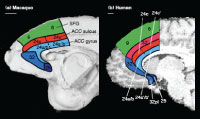Read the rest of the post.Cingulate Cortex and the Evolution of Human Uniqueness
Figuring out how the brain decides between two options is difficult. This is especially true for the human brain, whose activity is typically accessible only via the small and occasionally distorted window provided by new imaging technologies (such as functional MRI (fMRI)).
In contrast, it is typically more accurate to observe monkey brains since the skull can be opened and brain activity recorded directly.
Despite this, if you were to look just at the human research, you would consider it a fact that the anterior cingulate cortex (ACC) increases its activity during response conflict. The thought is that this brain region detects that you are having trouble making decisions, and signals other brain regions to pay more attention.
If you were to only look at research with monkeys, however, you would think otherwise. No research with macaque monkeys (the ‘non-human primate’ typically used in neuroscience research) has found conflict activity in ACC.
My most recent publication looks at two possible explanations for this discrepancy: 1) Differences in methods used to study these two species, and 2) Fundamental evolutionary differences between the species.
Initially, the methods difference seems like the obvious explanation. After all, directly recording brain activity with electrodes should be more accurate than recording blood flow caused by brain activity (like with fMRI).
There’s a twist to this story, however: Measuring blood flow may actually be more accurate than recording single-unit activity in some cases.
For instance, fMRI may be more sensitive to activity in interneurons (the small neurons usually ignored by single-unit recording). As it turns out, conflict activity in ACC is thought to involve exactly these sorts of interneurons. The idea is that populations of these small cells compete for dominance between the two decision outcomes. This would cause more blood flow in ACC for fMRI to pick up (in humans), but relatively little change in the large output neurons (recorded in monkeys).
This could completely explain the discrepancy between the species, except for three things that cast doubt on it: First, local field potentials, which detect interneuron activity, yielded no results in monkeys (Emeric et al., 2008). Second, cutting out the ACC of monkeys did not change monkeys’ decision-making behaviors (Mansouri et al., 2007). Finally, single-unit recording and local field potential recording in humans undergoing surgery found conflict activity in ACC (Wang et al., 2005; Davis et al. 2005), just as with fMRI.
These findings suggest another possibility: The discrepancy is explained by a fundamental difference in the brains of the two species.
Offering multiple perspectives from many fields of human inquiry that may move all of us toward a more integrated understanding of who we are as conscious beings.
Friday, November 20, 2009
Neurevolution - Cingulate Cortex and the Evolution of Human Uniqueness
Cool, geeky brain science stuff.
Tags:
Labels:
brain,
evolution,
Psychology
Subscribe to:
Post Comments (Atom)

No comments:
Post a Comment